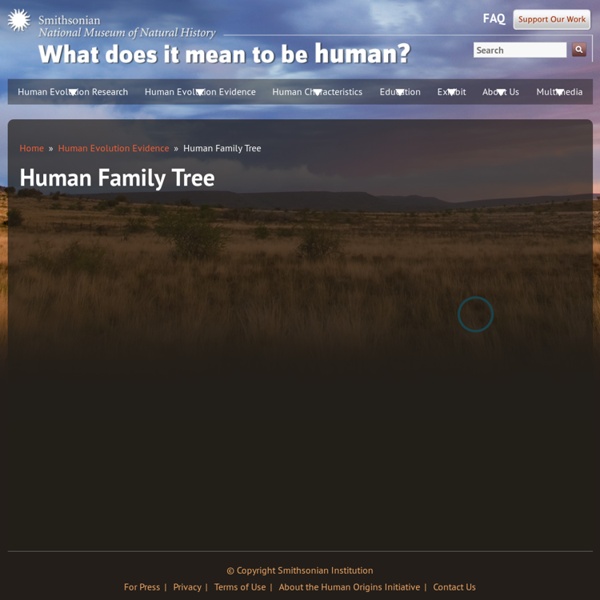



http://humanorigins.si.edu/evidence/human-family-tree
Related: PREHISTORYFree conservation biology textbook: Conservation Biology for All Oxford University Press makes conservation biology textbook by some of the world's most prominent ecologists and conservation biologists available as free download Conservation Biology for All provides cutting-edge but basic conservation science to a global readership. A series of authoritative chapters have been written by the top names in conservation biology with the principal aim of disseminating cutting-edge conservation knowledge as widely as possible. Important topics such as balancing conversion and human needs, climate change, conservation planning, designing and analyzing conservation research, ecosystem services, endangered species management, extinctions, fire, habitat loss, and invasive species are covered. Numerous text boxes describing additional relevant material or case studies are also included. The global biodiversity crisis is now unstoppable; what can be saved in the developing world will require an educated constituency in both the developing and developed world.
Cloning & Synthetic Biology Overview of Traditional Cloning Traditional Cloning refers to the generation of DNA fragments using restriction enzymes, and their subsequent assembly and transformation. The name is derived from the method’s history as the first widely-accepted cloning method. Learn more about the benefits and disadvantages of Traditional Cloning. scroll to see additional videos
Teach Prehistory! Teaching a unit on Prehistory can be very exciting! The course begins with an overview of prehistoric conditions on earth until about 1,000 B.C. We are talking about millions and millions of years in one unit, so obviously you need to focus on the absolute most important aspects of the prehistoric period. Evolution: Education and Outreach - Free Access Available As of January 2013 Evolution: Education & Outreach is a peer-reviewed open access journal published under the brand SpringerOpen. From 2013 onward all new articles published in the journal are freely and permanently available online for anyone, anywhere and at any time. This journal promotes accurate understanding and comprehensive teaching of evolutionary theory for a wide audience. Evolution: Education and Outreach addresses the question of why we should care about evolution by exploring the practical applications of evolutionary principles in daily life and the impact of evolutionary theory on culture and society throughout history. Targeting K-16 students, teachers and scientists alike, the journal presents articles to aid members of these communities in the teaching of evolutionary theory.
Early Human History Join our email newsletter to receive free updates! Close Search for Ideas and Resources An Error Occurred Setting Your User Cookie This site uses cookies to improve performance. If your browser does not accept cookies, you cannot view this site. Setting Your Browser to Accept Cookies Prehistory (Origins & Stone Age) Tip: Press ctrl and F (or Command and F on a Mac) to perform a keyword search of this page. To keyword search all Best of History Web Sites pages use the search engine located on each page. Prehistory in the News Before Lucy came Ardi, new earliest hominid found Associated Press, October 1, 2009 — “Ardi,” a 110-pound, 4-foot female hominid who lived 4.4 million years ago in what is now Ethiopia roamed forests a million years before the famous Lucy, long studied as the earliest skeleton of a human ancestor. Human’s Oldest Relative Found (from Discovery, on YouTube)
Timeline: The evolution of life - life - 14 July 2009 Read full article Continue reading page |1|2|3|4 There are all sorts of ways to reconstruct the history of life on Earth. Pinning down when specific events occurred is often tricky, though. Llengua anglesa Charles Darwin was born in the town of Shrewsbury, England on February 12, 1809. Since he was a child, Charles Darwin enjoyed an easygoing life - taking walks, collecting beetles, and playing with his dogs. When Charles was 16, His father, Dr. Darwin, sent Charles to the University of Edinburgh in Scotland to study medicine. A professor, John Steven Henslow, head of the botany department at the University, was impressed by Darwin's beetle collection. It was through Henslow that Darwin met Captain Robert Fitzroy of the Royal Navy. Celebrating 50,000 Generations of the Long Term Lines Front row: Ryan Quick, Chris Strelloff, and Brian Baer Standing: Justin Meyer, Jeff Barrick, Christian Orlic, James Dittmar, RohanMaddamsetti, Caroline Turner, Brian Wade, Mike Wiser, Neerja Hajela, Richard Lenski, Devin Dobias In Back: Zachary Blount Drawn by Zachary Blount